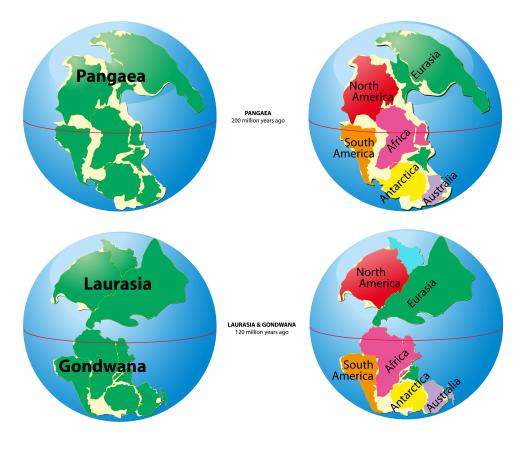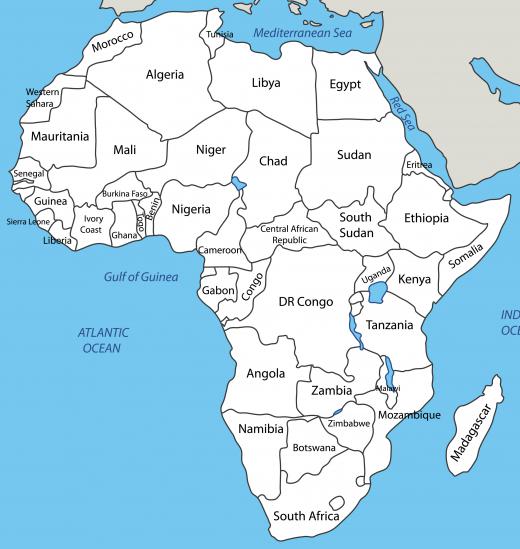What is a Continent?
 Michael Anissimov
Michael Anissimov
A continent is a large landmass defined by convention. There are currently seven on the Earth, which are as follows, in order of size: Australia, Europe, Antarctica, South America, North America, Africa, and Asia. All are inhabited, although Antarctica only has a population of about 4,000 during the summer and 1,000 during the winter. According to the most recent estimates, the population of Australia is roughly 22.6 million; Europe, 739 million; South America, 387.4 million; North America, 528.7 million; Africa, 1 billion; and Asia, 4.1 billion. The total world population is over 6.9 billion.
The continents were formed over the course of hundreds of millions of years through so-called orogeny ("rock birth") events, where a volcanic hotspot pours out hundreds of thousands of cubic kilometers of lava, which cools to create a craton, a large layer of rock. The fringes of cratons tend to be flooded, creating a continental shelf, which drops off abruptly into the deep sea. The area that they cover vary over geological time, as the Earth's ice sheets melt and refreeze. More than 40 million years ago, there were barely any ice sheets on the planet, and the world's sea levels were approximately 230 feet (70 meters) higher. Just 10,000 years ago, during the last Ice Age, when ice sheets covered much of the Northern Hemisphere, the seas were about 120 feet (35 meters) shallower, opening up areas of land such as the North Sea, the Flores Strait, and Bering Strait.

Continents drift on the mantle below, made of superheated rock with a plastic texture. Over geologic time, these land masses move, breaking apart and reforming in something called the supercontinent cycle. This is a cycle whereby the land alternatively merges together into one giant supercontinent and breaks apart into fragments. The last supercontinent, Pangaea, existed about 250 million years ago. Within the next 250 million years, the continents are expected to come together again into a giant mass that has been named Pangaea Ultima.

The rock making up these land masses is much older than the ocean floor between them. This is because the oceanic crust is constantly being drawn down into areas known as subduction zones, where the crust melts and returns to the mantle. In areas in the center of oceans known as rift valleys, magma comes up from the mantle, creating new land. So the ocean floor is only 50-100 million years old, while the land crust may be as old as 4 billion years.
AS FEATURED ON:
AS FEATURED ON:



















Discussion Comments
@fify-- As far as I know, a landmass can be called a "sub-continent" based on several different factors.
It could simply be because it's too small to be called a single continent, but still a large landmass. It could be called a subcontinent if it's separated from a continent because of a physical barrier like a mountain range. Or even political, social, religious differences from rest of the continent could be a reason.
India, for example is a sub-continent of the continent of Asia for several reasons. One is the presence of Himalayas separating India. The other is because the Indian people are ethnically very distinct from the rest of Asia.
India was actually a continent of its own before it collided with Asia. That was when the Himalaya mountain range formed. So even though it is part of the larger continent of Asia, it's also a sub-continent.
@anon46386-- I think it has to do with the size. It has to be a considerable size for it to be a continent. Islands are way too small to be continents. There are millions of islands on earth, most of them inhabitable. Can you imagine what would happen if we called each one a continent? It wouldn't make sense at all!
I understand why islands can't be continents, but I'm a little confused with the term "sub-continent." Anyone know the difference between a continent and a sub-continent? Is this because of convention too?
sarac - read the first line: "A continent is a large landmass defined by convention", emphasis on "defined by convention".
So then...what is the difference between an island and a continent? Why is Australia/New Zealand a continent and not an island?
Post your comments